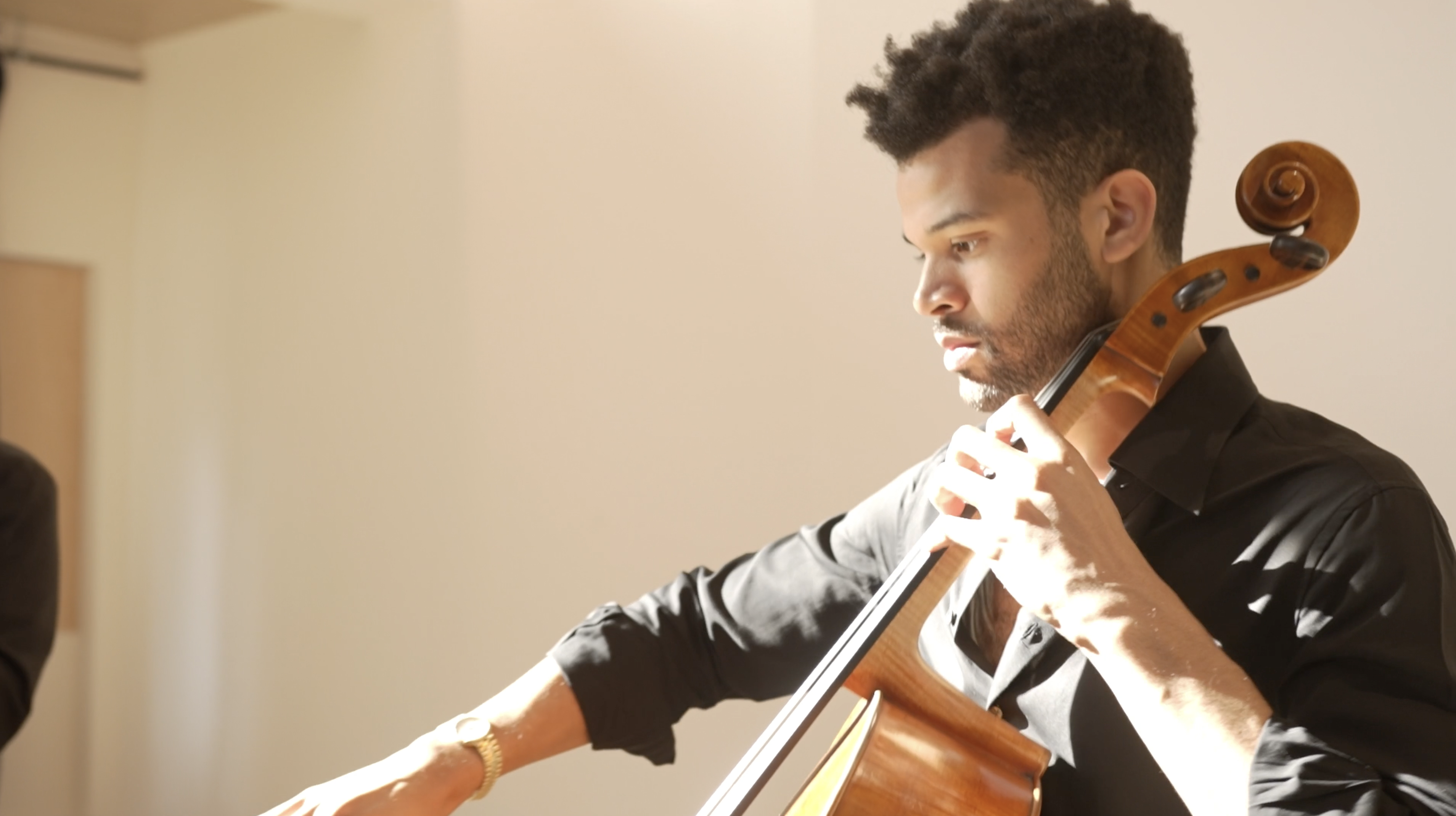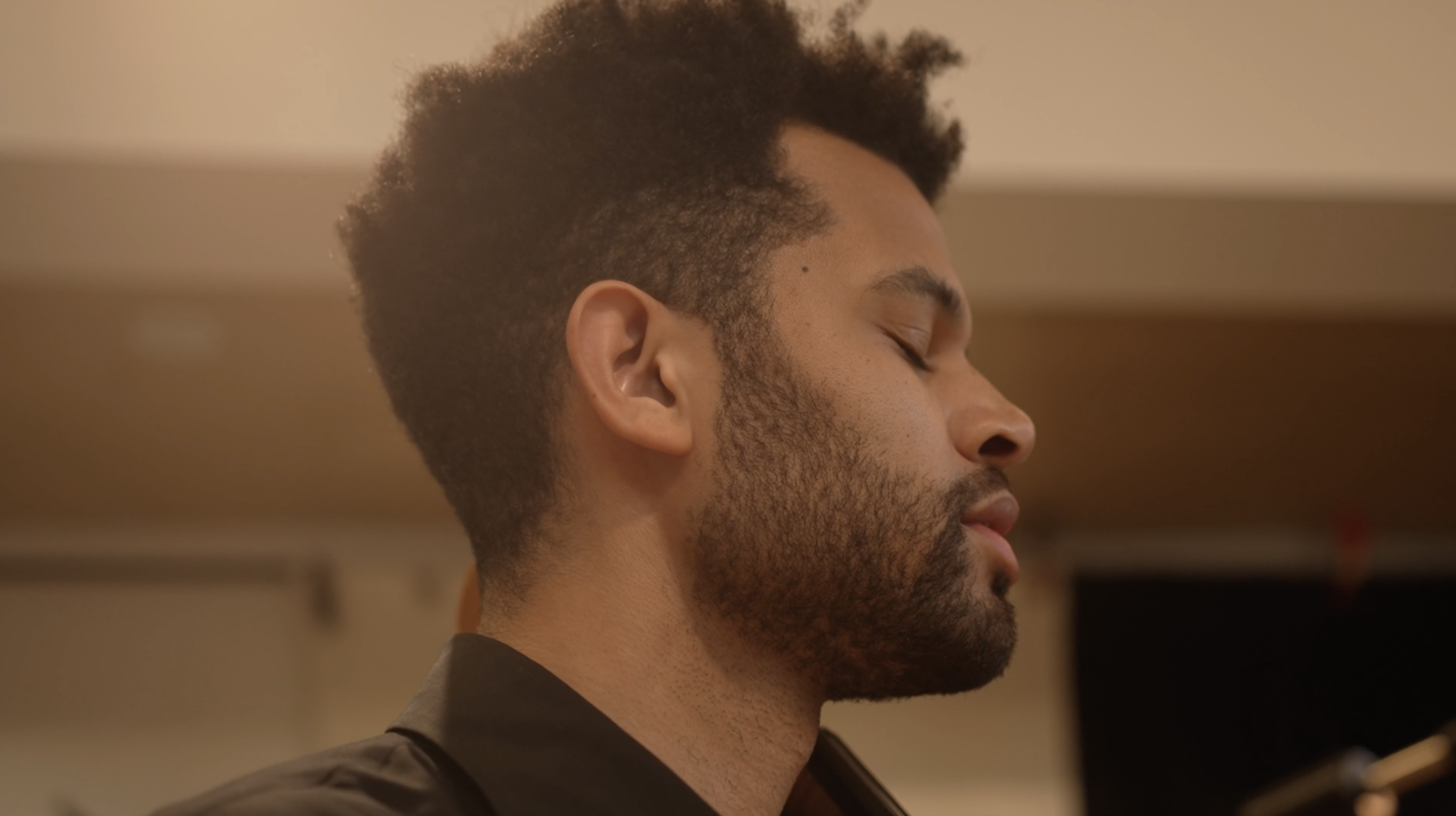
How Visual Art Becomes Music: Niles Luther on Composing Hiroshige
Meet Niles Luther, the Brooklyn Museum’s composer in residence, and hear about his project that responds to Utagawa Hiroshige’s 100 Famous Views of Edo.
Niles Luther, the Brooklyn Museum’s composer in residence, learned early in his training as a classical cellist that technique is meant to serve a story. Ideally, it serves many stories, including those of the music, its cultural context, the ensemble bringing it to life, and the composer whose voice rings through it.
Now, this concept informs Luther’s practice of composing “art music”—music that responds to the work of visual artists. This approach is rooted in his collaborations with Kehinde Wiley, including a pivotal performance at the Brooklyn Museum.
In conjunction with our new exhibition Hiroshige’s 100 Famous Views of Edo (feat. Takashi Murakami), Luther wrote compositions that respond to three of Japanese artist Utagawa Hiroshige’s prints: Chiyogaike Pond, Meguro; Kinryuzan Temple, Asakusa; and New Year’s Eve Foxfires at the Changing Tree, Oji. The recordings feature an ensemble of musicians on the violin, viola, koto, shakuhachi, and traditional Japanese percussion, with Luther on the cello.
To hear the compositions, download the free Bloomberg Connects app and navigate to the Brooklyn Museum’s digital guide. Come to the Museum to enjoy the music while viewing the prints in person. Hiroshige’s 100 Famous Views of Edo (feat. Takashi Murakami) is on view April 5–August 4, 2024.
Below, listen to Luther describe his process and see snapshots documenting the compositions’ creation, including the recording session at Elmwood Road Studios in South Salem, New York.
Transcript
My name is Niles Luther, and I am the composer in residence at Brooklyn Museum.
I’ve been a cellist my whole life, and it was always very classical in the beginning—going through the technique, learning the importance of technique, learning the rules of how to physically approach the instrument, and then using that to express something.
My first teacher, his name was Ole Akahoshi, and he’s the professor of cello at Yale School of Music, and I was studying privately with him. And his approach, which is different than most, always centered around this idea of expressive technique—this concept that the technique of the instrument should be in service of an expression, and if you have nothing to say, then the bow should never touch the string.
There was always such a focus in my lessons with him on having something in your head, in your heart, that you were desperate to express. And if you don’t have that sense of desire and desperation, and you don’t have that internal voice that is aiming so deeply to use the medium of music via the instrument of the cello to say something, then you shouldn’t say anything at all. So from a very young age, I was already focused on how to share a story, how to share a voice. What is my voice? What is my identity? And how can I incorporate that in my music in such a way that they can never be disentangled—that my voice, and therefore my music, is always connected?
If I can try and translate the medium that I see in front of me into something musical, how does that add to the conversation?
This is what was percolating in my mind and my background as I was growing up. And then one day, I got called to perform a gig. This was in 2015, and I was 17 at the time. And I had never really done a major performance in New York. I was living in Connecticut. But I was called through a music contractor in the city who told me, “Oh Niles, we have this extraordinary performance. It’s at the Brooklyn Museum. It’s the opening of a retrospective, A New Republic.”
At the time, I didn’t know who Kehinde Wiley was, and I didn’t really know anything about art, specifically contemporary art. But I had grown up going to museums and had always been drawn to visual manifestations of the creativity that I sought to express myself. I just hadn’t been exposed to it at that level. So, when I arrived at this opening and I saw what was going on, I saw the kinds of people that were walking through the Brooklyn Museum, and I saw the work hanging on the wall, I was just so overwhelmed in the best way possible. I said to myself, “This is the kind of environment that I want to be in for the rest of my life.” The people there, the work that Kehinde was creating, I felt represented part of that inner voice that I had, the voice that my teacher Ole was telling me to cultivate before I put my bow on the string. So that was really eye-opening for me.
Fast forward a couple years. It’s now 2019, and Kehinde starts exploring the genre of art film. I had recorded on the scores of his films leading up to that point and casually mentioned, “I don't think the music that’s being written accurately translates your visual aesthetic into music. And I think that there’s an opportunity here to capture the narrative that you’re cultivating and musicalize it.” And that offhand comment turned into, “Niles, you’re going to score my next film.”
It was really when I started on that film, scoring that film, that I realized this is where I want to express myself. And this is the platform that I can use, composition, to find a way to not only express myself, my personal attempt to revivify the canon, but find and identify my own voice through that process of revivification.
There’s this concept that really grips me and the idea is ekphrasis. It originates from the Greek tradition of transliterating a visual narrative into language. So, a poem about the Mona Lisa would be an example of ekphrasis. And the idea that is the foundation of this genre I’m calling “art music” is this idea of replacing language, a written language or oral language, with a musical one.
So musical ekphrasis. Then the question becomes, well, OK, if I can try and translate the medium that I see in front of me into something musical, how does that add to the conversation? I’m not just trying to be totally honest or faithful to the object I see, because I’m not the original creator of that art object. So there will never be a perfect translation of that visual into music. It’s more to respond to the visual, to try and be in dialogue with the visual, to use my personal experience and the tools I have at my disposal, which is the cello and the classical music tradition, to start a new dialogue and offer a new perspective that maybe allows diverse audiences to find a pathway into the artwork, possibly for the first time, and in a different light.
 Niles Luther is the Brooklyn Museum’s first composer in residence. (Photo: Kenneth Sousie)
Niles Luther is the Brooklyn Museum’s first composer in residence. (Photo: Kenneth Sousie)
When I first saw Utagawa Hiroshige’s ink-block prints and considered composing scores for them, I felt uncomfortable. I felt a little bit of fear because I didn’t know much about Japanese culture. And I was so drawn to the prints from an aesthetic and narrative perspective, looking at these objects in isolation and just seeing incredible masterworks.
That much was very apparent, but what was not apparent was how I would relate to them. And that was a gap in my knowledge that I felt would be worth pushing through and exploring further. This tension is what enlivens me and gets me interested in something, if it’s just beyond what I’m comfortable and capable of engaging with.
So it became very obvious what I had to do, which was invest heavily in educating myself on this tradition, and on this culture, and this time period of work, as well as the musical traditions that were prevalent in Japan during the Edo period: the instruments, timbres of the instruments, the performance technique, the scales and modes, and the general way that music was approached. Because it was such a foreign concept to me, that’s really what got me going, of, like, how can I learn as much as possible about this practice and then incorporate it into my own practice in a way that is honest to who I am?
There are certain philosophical elements related to the Japanese tradition that helped me. For instance, this concept called ma, which relates to the negative space in music and ideas. So, in a Buddhist temple, ma represents space around an object within a garden. And the motif should be surrounded by negative space so that motif can be appreciated fully. I feel this contrasts heavily to the Western tradition of cultivating motif, of surrounding it with supportive elements that enhance it, instead of this concept of negative space and as that translates into silence. It’s often uncomfortable for a Western ear to have a motif that is lacking in deeply cultivated harmonic or rhythmic support.
So I already felt like that would be a challenge for me, to pare down some elements of these compositions, because then all the attention would be focused on one line or one idea. And then that one line or idea has to carry all the nuance and depth that’s attempting to be expressed. That was a major challenge.
 Yumi Kurosawa plays the koto at a recording session on March 13, 2024. (Photo: Kenneth Sousie)
Yumi Kurosawa plays the koto at a recording session on March 13, 2024. (Photo: Kenneth Sousie)
Additionally, learning how to write for the traditional instruments that I wanted to work with, which was the koto, for instance. Learning how many strings are on a koto, which goes from 13 all the way up to 25, and working with the shakuhachi, which, unlike a piano, doesn’t place equal weight on each note in the 12-tone scale; as well as traditional Japanese percussion, the taikos, as well as the furin, which is the bell dangling in the wind that you might find in a Buddhist temple. So finding a way to work with these instruments within the Western notation, which is not inherently supportive of these instruments, was a challenge.
My approach to overcoming these challenges manifested in workshopping with the musicians, talking to them, going to their apartments, going to their places, seeing these master performers play their instruments, and having a dialogue. What is possible? What is not possible? OK, we’ve established what is possible—now, what is artistically excellent? How would you interpret this? How would you improvise [while] looking at this print? They had to play with a violin, viola, and cello. And my writing is very Western, obviously coming from the Western European classical tradition. So finding a way to marry these two seemingly opposite traditions was a challenge. But I found we were able to broach this by having a dialogue, having a back-and-forth and letting these traditional Japanese instrumentalists find their own path through the composition that had been written and adding their own interpretation to the score.
This project features Corinne Au, violin; Yumi Oshima, viola; Niles Luther, cello; Yumi Kurosawa, koto; Kojiro Umezaki, shakuhachi; Fumi Tanakadate, percussion; Corinne Segal, executive producer; Jarvis Benson, session producer; Wondersmith Entertainment, contractor; Silas Brown, audio engineer; and Ian Streidter, editing engineer.
Corinne Segal is Senior Digital Producer at the Brooklyn Museum.